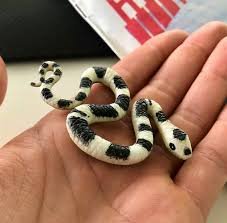Introduction
The natural world is brimming with creatures that captivate our imagination, and among them, black and white snakes stand out as some of the most striking. These reptiles, found across diverse ecosystems globally, often spark both intrigue and misconceptions. While their bold colouration is undeniably eye-catching, it does not, on its own, reveal whether a snake is venomous or harmless. Understanding these remarkable serpents, from their biology to their behaviour, is crucial for safe observation and responsible interaction.

The Science Behind Black and White Coloration
Albinism and Leucism: Understanding Pigment Loss
The vivid white or pale segments seen in some snakes are frequently a result of genetic conditions affecting pigment production.
- Albinism is a genetic mutation that inhibits melanin production, leading to pale skin and red or pink eyes. Albino specimens of the Common Krait are extremely rare.
- Leucism causes partial pigment loss without affecting eye colour. A leucistic Texas rat snake is a notable example.
(Image suggestion: Albino snake with caption and alt text “Albino black and white snake showing pigment loss”)
Mimicry and Aposematism: Nature’s Warning Signals
- Batesian Mimicry: Harmless snakes like milk snakes mimic venomous coral snakes to avoid predators.
- Aposematism: Striking patterns serve as warnings, as in the mildly venomous bandy-bandy snake.
(Image suggestion: Milk snake beside coral snake, alt text “Milk snake black and white mimic of coral snake”)
Key Characteristics for Identification
When identifying black and white snakes, colour alone isn’t enough. Look at:
- Head shape (triangular vs rounded)
- Body patterns (rings, bands, blotches)
- Size and build
- Geographic location
- Scalation (arrangement of scales, anal plate, presence/absence of loreal scales)
(Image suggestion: Diagram comparing head shapes of venomous vs non-venomous snakes, alt text “Black and white snake identification features”)
Fascinating Black and White Snake Species
The Enigmatic Bandy-Bandy Snake (Vermicella annulata)
- Striking black and white rings encircling the body
- Nocturnal and feeds mostly on blind snakes
- Mildly venomous but harmless to humans
- Known for looping defensive display
(Image suggestion: Bandy-bandy snake in defensive posture, alt text “Bandy-bandy black and white snake defensive display”)
The Dangerous Kraits (Bungarus species)
- Common Krait (B. caeruleus): Highly venomous, found in South Asia.
- Many-banded Krait (B. multicinctus): Extremely venomous, found in China and Southeast Asia.
- Suzhen’s Krait (B. suzhenae): Recently identified species, deadly neurotoxic venom.
(Image suggestion: Common krait on forest floor, alt text “Common krait venomous black and white snake”)
Non-Venomous Mimics: Milk Snakes (Lampropeltis triangulum)
- Brightly coloured with black, red, and white/yellow bands
- Harmless constrictors, often kept as pets
- Example of Batesian mimicry against coral snakes
(Image suggestion: Eastern milk snake, alt text “Non-venomous milk snake black and white patterned constrictor”)
Other Notable Species
- Common Kingsnake (Lampropeltis getula) – Immune to venom, eats other snakes
- California Kingsnake (Lampropeltis californiae) – Popular pet species
- Black-tailed Rattlesnake (Crotalus molossus) – Venomous viper with black tail
- Wolf Snakes (Lycodon species) – Harmless but mimic kraits
- Striped Whipsnake (Masticophis taeniatus) – Slim, fast, non-venomous predator
Internal Link: https://pesteraser.in/
Safety and Conservation
- Safety First: Never handle snakes unless you are trained. Seek immediate medical help after bites.
- Conservation: Many species face threats from habitat loss. The Weipa bandy-bandy is endangered by mining operations.
(Internal link suggestion: [Snake Safety Tips and First Aid Guide])
Snakes in Mythology and Culture
Snakes have been revered and feared across cultures:
- India: Nagas symbolise fertility and immortality.
- Egypt: Cobras symbolised power and royalty.
- Greece: Snakes represent both healing (Asclepius) and danger (Medusa).
- Native America: Snakes embody transformation and healing.
(Internal link suggestion: [Symbolism of Snakes in Mythology])
Conclusion
From the harmless milk snake to the deadly krait, black and white snakes embody both mystique and biological marvel. Their striking patterns serve purposes ranging from camouflage to mimicry, while their cultural significance underscores humanity’s long-standing fascination with serpents. By learning about these creatures, we not only gain respect for their role in ecosystems but also contribute to their conservation.





